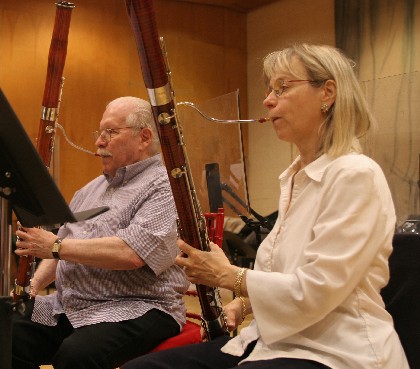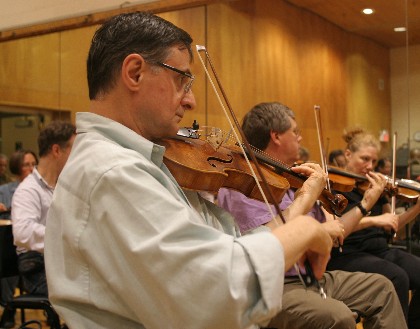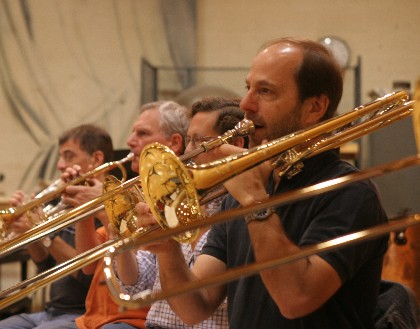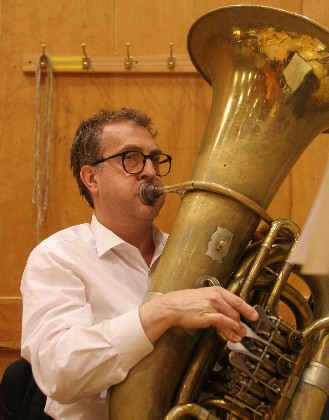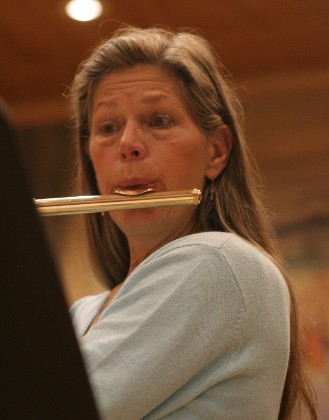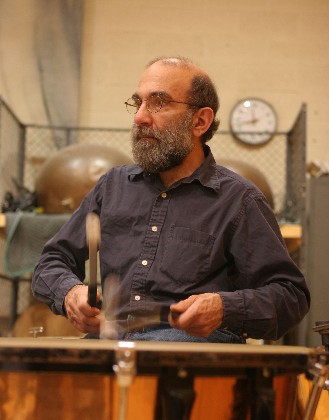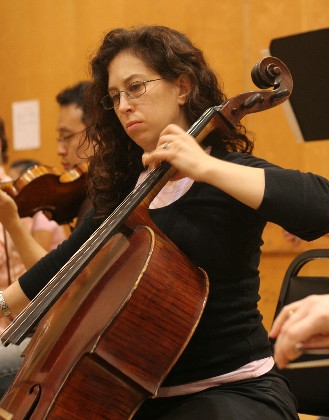Allegro
Keeping it Live!
ABT Agrees to Ban Machine as Part of New Contract
Volume CV, No. 7/8July, 2005
Two full months of difficult negotiations have led to a new three-year agreement between Local 802 and the American Ballet Theatre, which includes a ban on the virtual orchestra machine. The ballet now becomes the first resident orchestra at Lincoln Center to ban the machine, following similar pledges by Lincoln Center’s Vivian Beaumont and Mitzi Newhouse Theatres.
“The virtual orchestra machine ban is so important because dance audiences are becoming more and more subjected to hearing tapes,” said Dave Wilson, a percussionist in the ballet and a member of the orchestra committee.
Negotiations concluded on May 22, less than 24 hours before the downbeat of the ballet’s annual gala at the Metropolitan Opera House.
Throughout the talks, the two major stumbling blocks were management’s refusal to ban the machine and to offer acceptable wage increases.
The ballet had insisted that its new management team needed time to get its financial situation stabilized. Ballet administrators told us that everyone working for the company, including musicians, needed to be “part of the solution.”
Earlier in the year the administrative staff had taken an unpaid furlough for a short period of time. Managers told us that similar cooperation was needed from the musicians in the form of reduced financial expectations.
Additionally, the future capabilities of the virtual orchestra machine were an unknown so ballet management was simply unwilling to agree to a ban.
Both positions of management were unacceptable to the musicians and the union.
On May 18, some members of the orchestra, the orchestra committee, legal counsel Leonard Leibowitz and I met with the ballet dancers to inform them how the negotiations were going, including management’s insistence on its ability to use a V.O. machine. We asked the dancers for their support in the event of a labor action. The meeting concluded with a round of applause from the dancers for the musicians.
That same evening the orchestra committee met with their fellow musicians. We took a strike authorization vote, which the musicians approved overwhelmingly.
During a previous negotiating session, ballet management had asked to bring in a federal mediator. We believed that negotiations had now reached a point where a mediator might be useful, so we agreed.
The mediator attended the next session on May 20, but despite her presence, little progress was achieved. Negotiations broke off with no further meetings scheduled.
The next day the orchestra committee met to prepare for an upcoming labor action. Press releases and future picketing were discussed.
Then, late Saturday night, the federal mediator called, asking for a negotiating session for Sunday afternoon.
During this 11th-hour session with a strike looming, and with 802 President Lennon’s assistance, a tentative settlement was reached, which musicians later ratified. Here are highlights from the agreement:
- Management agreed to ban the V.O. machine. Achieving this ban is critically important to the union’s ongoing fight to promote live music.
- Wages were increased. The current wages are $1,600 per week. These will increase to $1,632 in year one; $1,675 in year two; and $1,725 in year three.
- The hourly rehearsal wage will increase. Currently, rehearsals pay $45 per hour. They will now pay $46 in year one, $47.50 in year two and $50 in year three.
- For the first time, management agreed to make health contributions for rehearsals, which will pay $9 each.
- For performances, health contributions will be $27 in year one, $28 in year two and $30 in year three. (These contributions are for all musicians who do not qualify for automatic Plan A for six months and automatic Plan B for six months by performing 75 percent of all performances during any contract year.)
- The shortfall health fund (for musicians on the roster who fall short of meeting the eligibility requirements for either health plan) will immediately increase to $10,000 from $9,000. Musicians can tap into this fund if they fall short of meeting the eligibility requirements for either health plan.
- Currently the ballet contributes $12,000 towards the premium for individual catastrophic health insurance. This contribution will increase to $18,000 in the third year of the contract.
- Pension remains at 16 percent during the three years of this contract.
“Although there were aspects of the negotiations that were discouraging, we were pleased to achieve a contract that maintains benefits, has a modest increase in wages and includes the important ban on the virtual orchestra machine,” said Maureen Hynes, a cellist and member of the orchestra committee.
Bassoonist Bernadette Zirkuli, who also served on the committee, agreed. “Considering the present climate towards musicians, I think we did the best we could while preserving our integrity, good will and continued employment of this body of fine live musicians and tremendously gifted dancers,” Zirkuli told Allegro.
Olivia Koppell, who plays viola in the orchestra and who served on the committee in years past, said, “I thought it was difficult at times, but ultimately it was a good outcome for the members of the orchestra and for live music in general – and also for the company, which the musicians all love and feel very much a part of.”
Koppell added, “The orchestra committee worked so hard and so well together. While they might have to compromise at times, they never compromise their principles. What they do is in everyone’s best interests. They deserve our appreciation.”
Karen Purpura, a flutist in the orchestra and a member of the committee, said, “Although I am disappointed with our wage package and the underlying anti-union attitude of the management, I feel that the inclusion in the contract that the virtual orchestra machine will never be used to replace the ABT orchestra is a triumph for the Lincoln Center orchestras and for the industry.”
The orchestra committee was comprised of Frank Donaruma, Maureen Hynes, Karen Purpura, Jack Wenger, Dave Wilson and Bernadette Zirkuli. Other members of the orchestra assisting the committee were Olivia Koppell, Lou Barranti and Tom Olcott, assisted by Local 802 counsel Len Leibowitz.
Local 802 wishes to thank the various orchestra members who attended the negotiations in support of their fellow musicians; the ballet dancers; Lori Rosecrans Wekselblatt, the ballet’s principal stage manager and vice president of the dancers’ union; and Mike Wekselblatt, theatrical business manager for IATSE (Local 1).
|
|
|

